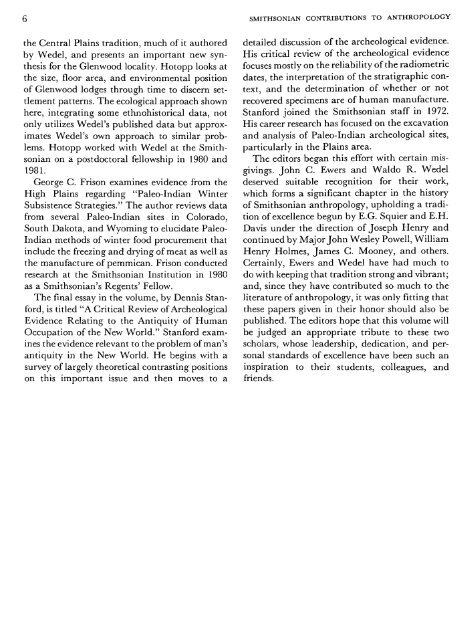Plains Indian Studies - Smithsonian Institution Libraries
Plains Indian Studies - Smithsonian Institution Libraries
Plains Indian Studies - Smithsonian Institution Libraries
Create successful ePaper yourself
Turn your PDF publications into a flip-book with our unique Google optimized e-Paper software.
the Central <strong>Plains</strong> tradition, much of it authored<br />
by Wedel, and presents an important new synthesis<br />
for the Glenwood locality. Hotopp looks at<br />
the size, floor area, and environmental position<br />
of Glenwood lodges through time to discern settlement<br />
patterns. The ecological approach shown<br />
here, integrating some ethnohistorical data, not<br />
only utilizes Wedel's published data but approximates<br />
Wedel's own approach to similar problems.<br />
Hotopp worked with Wedel at the <strong>Smithsonian</strong><br />
on a postdoctoral fellowship in 1980 and<br />
1981.<br />
George C. Prison examines evidence from the<br />
High <strong>Plains</strong> regarding "Paleo-<strong>Indian</strong> Winter<br />
Subsistence Strategies." The author reviews data<br />
from several Paleo-<strong>Indian</strong> sites in Colorado,<br />
South Dakota, and Wyoming to elucidate Paleo-<br />
<strong>Indian</strong> methods of winter food procurement that<br />
include the freezing and drying of meat as well as<br />
the manufacture of pemmican. Prison conducted<br />
research at the <strong>Smithsonian</strong> <strong>Institution</strong> in 1980<br />
as a <strong>Smithsonian</strong>'s Regents' Fellow.<br />
The final essay in the volume, by Dennis Stanford,<br />
is titled "A Critical Review of Archeological<br />
Evidence Relating to the Antiquity of Human<br />
Occupation of the New World." Stanford examines<br />
the evidence relevant to the problem of man's<br />
antiquity in the New World. He begins with a<br />
survey of largely theoretical contrasting positions<br />
on this important issue and then moves to a<br />
SMITHSONIAN CONTRIBUTIONS TO ANTHROPOLOGY<br />
detailed discussion of the archeological evidence.<br />
His critical review of the archeological evidence<br />
focuses mostly on the reliability of the radiometric<br />
dates, the interpretation of the stratigraphic context,<br />
and the determination of whether or not<br />
recovered specimens are of human manufacture.<br />
Stanford joined the <strong>Smithsonian</strong> staff in 1972.<br />
His career research has focused on the excavation<br />
and analysis of Paleo-<strong>Indian</strong> archeological sites,<br />
particularly in the <strong>Plains</strong> area.<br />
The editors began this effort with certain misgivings.<br />
John C. Ewers and Waldo R. Wedel<br />
deserved suitable recognition for their work,<br />
which forms a significant chapter in the history<br />
of <strong>Smithsonian</strong> anthropology, upholding a tradition<br />
of excellence begun by E.G. Squier and E.H.<br />
Davis under the direction of Joseph Henry and<br />
continued by Major John Wesley Powell, William<br />
Henry Holmes, James C. Mooney, and others.<br />
Certainly, Ewers and Wedel have had much to<br />
do with keeping that tradition strong and vibrant;<br />
and, since they have contributed so much to the<br />
literature of anthropology, it was only fitting that<br />
these papers given in their honor should also be<br />
published. The editors hope that this volume will<br />
be judged an appropriate tribute to these two<br />
scholars, whose leadership, dedication, and personal<br />
standards of excellence have been such an<br />
inspiration to their students, colleagues, and<br />
friends.

















